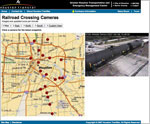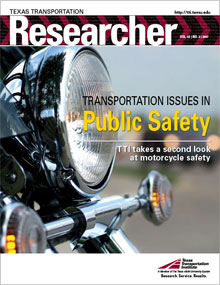
Everyone’s been delayed by a train at a roadway crossing. Usually, you’re in your car, tapping your fingers. But if you were standing at the crossing and the train was actually stopped, wouldn’t you be tempted to step between the cars and be on your way?
If you said yes, you would not be alone. Stories have circulated around Houston for years about people—particularly children—crawling between train cars to get through a blocked intersection. The situation presents an obvious safety hazard, not to mention potential liability issues for the railroad and agencies responsible for managing the crossing. Preventing individuals from walking between the cars is a tall order, so Texas Transportation Institute (TTI) Associate Research Scientist Darryl Puckett took a different course to address the problem.
“We decided to focus on the situation that enables the behavior rather than the behavior itself,” explains Puckett. “The problem occurs when the train is stationary, so we looked at how to minimize train stoppages at rail grade crossings.”
With the help of the City of Houston and Houston TranStar, TTI researchers monitored 19 crossings around the Houston area identified by the public as being problematic for stopped trains. Since many of these crossings are near schools, safety is compromised when children crawl through the cars to or from school. And, if a crossing is blocked, fire, police and emergency medical services (EMS) personnel must either wait for it to clear or find an alternate route. Actively monitoring these sites and implementing long-term improvements that minimize delays could enhance response time for first responders as well.
“We are adapting the traffic management system model implemented on Houston’s freeways,” explains Jack Whaley, director of Houston TranStar, the region’s transportation and emergency management center. “As with the freeways, we believe that monitoring railroad crossings can improve mobility, as well as safety.”
In its initial stages, the project developed a Web site where images of the crossings could be monitored by the Union Pacific dispatcher in Spring, Texas. It was envisioned that knowledge of the blockages could be used to bring resources to bear in clearing problem locations.
A prototype Web site was created to notify Houston Police Department (HPD) dispatchers of crossing blockages. When a crossing is blocked, the symbol on the site for that intersection changes from green to red, signifying that the crossing arms are down. After 10 minutes of continuous delay, the HPD dispatcher receives notification of the problem, and an officer can be sent to the location to investigate. The railroad involved is also notified. With that data, traffic management personnel can immediately contact the proper authorities to clear the crossing in the short term, while railroad personnel can assess it for long-term improvements. And, as with the freeway system already in place, the public is granted access to the Web site to use in facilitating their commute.
Puckett and his team recommended an expanded field test of the prototype Web site to eight locations to gather more data and further assess the effectiveness of the notification system in reducing the number of delayed trains. Other data, such as the extent of delays for emergency response personnel and the number of individuals walking through stopped trains, could also be gathered.
“TTI’s research can help us prioritize rail grade crossings that are particularly troublesome,” says Whaley. “With this data and through future expansion of the monitoring program, we have the potential for improving safety near schools, reducing EMS response time and improving mobility for commuters in one fell swoop.”
